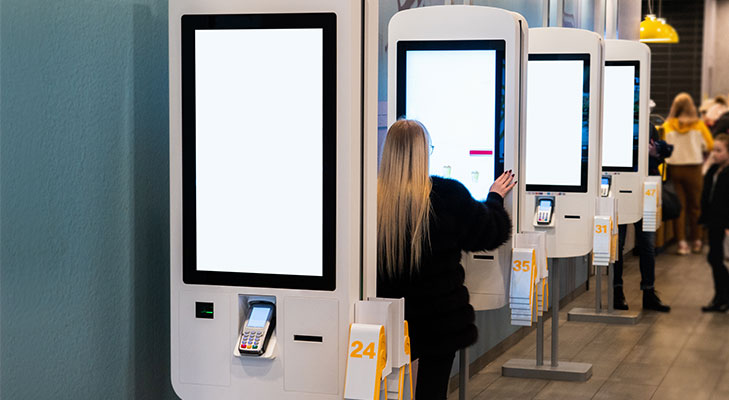The Seemingly Permanent Pandemic Effect on Quick-Service Restaurants
Published on November 15, 2021Share Tweet Share
The Covid-19 pandemic has changed many things in the world over recent years, and many businesses have suffered because of it. The Quick-Service Restaurant (QSR) industry has been hit just as hard, but thanks to some quick thinking they found ways to pivot and change things up in order to survive. Some of their actions have worked extremely well and some haven’t, but they all have been necessary. Some of the biggest changes may even outlive the pandemic and help redefine what it means to run a QSR establishment. Here are some of them.
Smaller Menus: One of the biggest things QSRs did almost immediately after the pandemic began was shrink their menu size. It helped them cut costs, yet still allowed them to deliver what their customers were looking for. Some of the bigger names like McDonalds and KFC joined in, and even they haven’t said if the smaller menu is here for good, or whether some items will slowly return. It is looking however like it will be a permanent change.
Dine-In Eating: While dining-in has started happening again, QSRs have been forced to limit the amount of people in their restaurants, and more space has been added between tables. Tightly packed dining areas will be a thing of the past, at least for the foreseeable future. Guests will also only be able to sit in designated areas and won’t be able to move tables and chairs around to accommodate larger parties. Crowded indoor pick-up areas are also a thing of the past as QSRs are encouraging people to use pick-up windows and drive-thrus instead of coming inside.
Contained Food: For many people, dining-in at a QSR brings memories of plastic trays and open food. Those days are now gone, with QSRs handing out the food in a closed (sometimes sealed) bag so that the food will be exposed to as few of people as possible. To avoid customers standing around waiting for the food as well, many QSRs are now delivering the food directly to the customer’s table.
Masks and Plexiglass Shields: No matter where you go these days, people are wearing masks. It’s the same for employees at QSRs. It doesn’t matter if you are going through the drive-thru, dining-in or getting the food delivered to you, the person handing you food will be wearing a mask. Wearing masks in public is the new norm, and it will be for a long time. The same goes for the plexiglass shields that were installed as social distancing barriers between point-of-purchase locations and customers. QSRs spent a lot of money installing them and likely won’t be removing them when things start to clear up.
Self-Serve Soda: Many QSRs such as McDonalds, Burger King and Popeyes have done away with self-serve soda fountains since the pandemic began. They cited coronavirus precautions, and there has been no word if, or when, they will return. Many specialty drink QSRs such as Starbucks have even eliminated customers from using their own reusable cups.
Shared Condiments: In order to be more environmentally conscious, many QSRs offered the option of using a shared station instead of little plastic packets for their ketchup, mustard and other condiments. Customers could also find packages of salt and pepper, butter and other items at these stations. These have now been removed, with the server having to hand them out to the customers once again. Even specialty drink QSRs have done away with their milk, cream and chocolate or cinnamon sprinkles station, forcing customers to get employees to add it for them instead.
Napkin dispensers: When you do decide to dine-in at a QSR, you won’t find a napkin dispenser anywhere. Much like self-serve soda and shared condiments, napkin dispensers have been deemed risky, and have been removed from restaurants. You can still get napkins of course, but you need to ask for them at the counter instead.
Paying With Cash: Even before the pandemic we were moving towards a cashless society. Places were making it easier to pay with credit and debit cards, and with the introduction of tapping people were carrying less cash on them. QSRs had even started providing their customers with ways of paying through their apps ahead of time, which not only sped up wait times, but made it more convenient for them. When the pandemic struck, many QSRs told their customers that they weren’t accepting cash for the time being and with human habits what they are, many probably won’t go back to it once covid-19 has passed us by.
Store Closures: As unfortunate as it is, many QSRs have seen locations close around the country. When things improve some may return, but in all likelihood very few of them will. While this does help with the over-saturation the industry has seen in the last few years, it’s never a good thing. What it also does however is open the door for new and emerging QSR brands. It gives them an opportunity to put themselves in front of the consumer with less noise from their competition. Franchisees that have been forced to close their doors may also look to re-open a different franchise or the same one in a different location. It’s a good time for businesses to get moving.
While some of the permanent changes may surprise customers, many of them were coming anyway and may lead to a better path in the long run. The biggest thing to take from it is that new QSRs will come out of it, and both them, and established QSRs, may be stronger because of it.
Not sure how much can you afford?
Fill out our Franchise Affordability Calculator


Voyage Franchising

